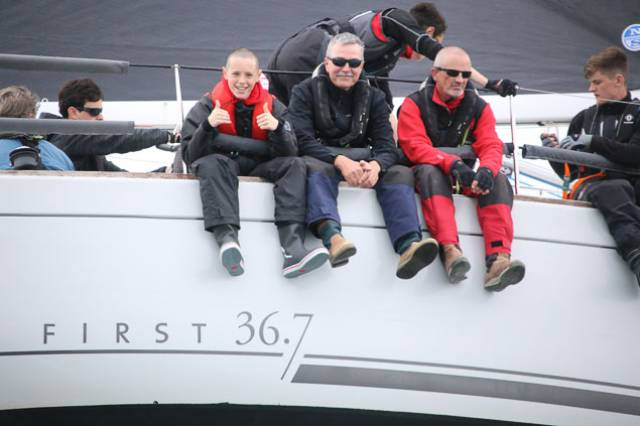It’s highly likely that a trial Olympic offshore racing event will be run in tandem with the 2020 Sailing Olympiad in Tokyo in 2020, and one proposal which seems to have traction is that a boat similar to the Figaro will be used, and raced two-handed by a mixed male-female crew writes W M Nixon.
Whatever shape the future Olympic offshore format takes, such a development is bound to move parts of the current world offshore racing scene towards a more formalized training structure for young sailors. And for offshore racing high-flying hopefuls of limited resources, it may ultimately offer the seemingly attractive prospect of funding becoming available though official sources.
Yet equally it will require commitment and a defined career path which could be a whole world away from the current varied scene in Ireland where young people – some of them surprisingly young – find a genuine enthusiasm for offshore racing happily fulfilled by crewing aboard a sailing school or family boat, or racing with skippers who know that a dedicated and talented young offshore sailor, recruited through the always busy sailing grapevine, can be a real asset, often with true skipper potential.
But how far does such talent want to go in pursuing offshore sport? When 20-year-old Erwan le Draoulec won the 2017 Minitransat by a significant margin last November, while his win wasn’t unexpected (even if it gave further proof that you don’t have to be through your mid-20s to have super-human stamina), his reaction was something of a surprise. He’d sailed the very wet little boat to the absolute limit, he’d done the job very well indeed, yet he’d no hesitation afterwards in saying that it was a very stressful and definitely not enjoyable way to cross the Atlantic, and that in the future some time, he would hope to make the crossing in a more thoughtful style which fully appreciated the very special qualities of the great ocean.
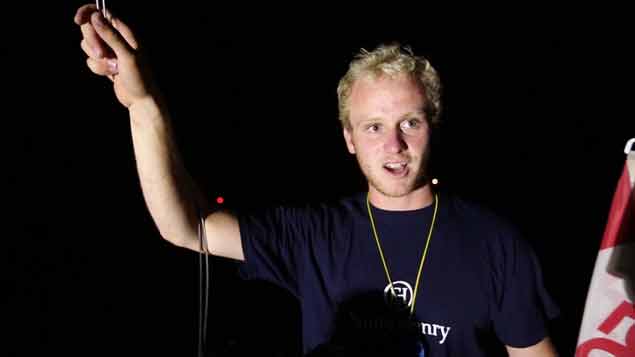 Youngest-ever winner. 20-year-old Erwan le Draoulec at the finish of the Mini Transat, November 2017
Youngest-ever winner. 20-year-old Erwan le Draoulec at the finish of the Mini Transat, November 2017
Such an outcome, reflecting one result of the uniquely French approach to dedicated offshore programmes with a high-powered training structure though classes such as the Mini-Transat and the Figaro, tell us why Irish solo sailors such as Tom Dolan from Meath, and Joan Mulloy from Mayo, have concluded that the only way to advance their careers is to commit to the French system, and both now sail in the Figaro network through which Damian Foxall and David Kenefick also progressed.
But there’s an all-or-nothing element to that dedicated Gallic approach which inevitably involves living in France, and is at variance with the underlying Corinthian ethos in Irish sailing, with its wholesome friendly atmosphere, and the fact that we enjoy sailing with family and friends, and being based here.
It can be argued, of course, that if we’re going to produce sailors in any discipline who are going to achieve top level international success to Olympic level, then we have to produce athletes who are as tough-minded and self-reliant as they are talented and physically able, and have to accept that they should be prepared to go anywhere and everywhere to pursue their goals.
But not everyone necessarily aims that high, and it would be a very unhealthy state of affairs if they did. Certainly they wish to do well in their chosen branch of the sport, but it’s at a civilized level, and for these junior offshore racing aspirants, Ireland is a happy hunting ground.
Yet by the very nature of the offshore sport, you cannot have children’s and youth boats which would be the offshore equivalent of the Optimist or the International 420 - anyone who thinks the Mini Transats are kids’ boats clearly has never sailed one.
So in a variety of ways, active berths have to be found for younger people on grown-up boats, and some of these younger people are very young indeed. One of the stars of 2017 may have been 17-year-old Lorcan Tighe of Dun Laoghaire, who played a key role in the Irish National Sailing School’s class win with the J/109 Jedi in the Rolex Fastnet Race, for which he was made Sailor of the Month for September 2017. But he was already building on past experience – at the age of 16, he’d been bowman on Peter Hall’s Beneteau 34.7 Adelie in the Volvo Round Ireland 2016 from Wicklow.
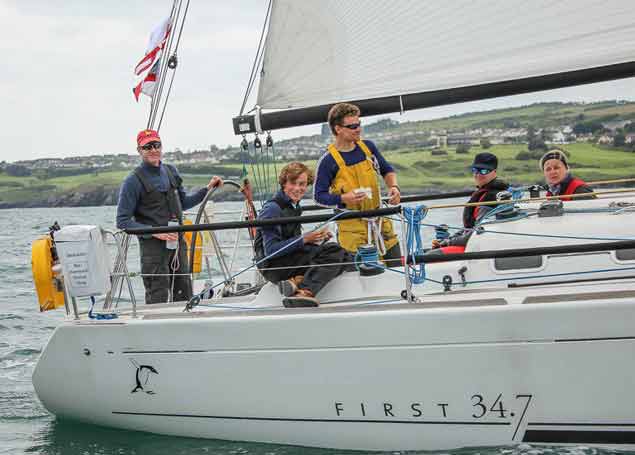 Noel Butler (on helm) and Lorcan Tighe (then aged 16) on Peter Hall’s First 34.7 Adelie. Photo: David O'Brien/Afloat.ie
Noel Butler (on helm) and Lorcan Tighe (then aged 16) on Peter Hall’s First 34.7 Adelie. Photo: David O'Brien/Afloat.ie
 Further recognition. Lorcan Tighe with National YC Commodore Ronan Beirne and the Commodore’s Commendation Award for his 2017 Fastnet Race performance
Further recognition. Lorcan Tighe with National YC Commodore Ronan Beirne and the Commodore’s Commendation Award for his 2017 Fastnet Race performance
And as a result of highlighting his achievement, we were quickly informed that several younger sailors had done the round Ireland, with a name quickly mentioned being that of Susan Shanahan of the National YC who was actively offshore racing as crew for her father Liam – stalwart of ISORA, the Round Ireland and the Dingle race - from the age of 12, for in these races there’s no lower age limit, although full Parental or Guardian permission is of course required for those under 18.
At the other side of the country, the legendary Dillons – father and son Derek and Conor from Foynes – were and are a formidable force offshore in double-handed racing with their Dehler 34 The Big Deal, and Conor was making an impact at the age of 14, while another Shannon Estuary sailing family, the McGibneys of Tarbert – were introducing youth sailors to the offshore game from an early age.
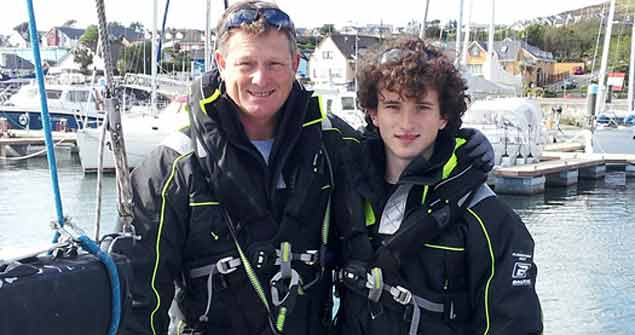 Shannon talent. Derek and Conor Dillon from Foynes provide a notable example of different generations racing offshore together.
Shannon talent. Derek and Conor Dillon from Foynes provide a notable example of different generations racing offshore together.
In fact, the extraordinary range of family crews bringing “cradle sailors” along to take part in offshore races from a very young age put us into new territory. For at what age does a child aboard an offshore racer start graduating into an active crew member? It’s when you try to put a figure on it that you realise that mere chronological age is a very crude measure. Every young sailor is different, and someone who is already a natural at 14 can be a much more useful crew than an able-bodied but less experienced 20-year-old.
It’s probably in Cork that they know more about when cradle sailors develop into real offshore crew members and skipper material, with family sailing and racing being so much part of the fabric of life that it’s seen as something so natural that it’s scarcely worth any special comment. But for sailors from elsewhere, it really is impressive when you see a mighty sailing clan like the O’Learys of two or more generations putting in a campaign where seniority is no matter of natural respect on board – it’s how much of a useful input you make into the boat’s successful functioning that counts.
One noted skipper who brings a special dedication and insight to family involvement in offshore racing is Liam Coyne of Dun Laoghaire, who with Brian Flahive won the two-handed division and several classes in the Round Britain & Ireland Race of 2014 in the First 36.7 Lula Belle.
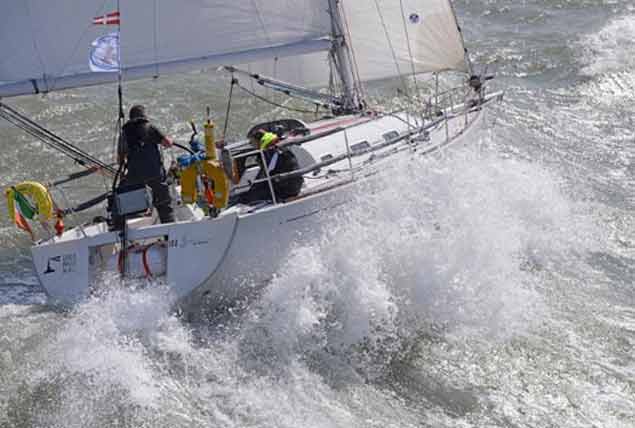 Rough going. Lula Belle at the start of the Round Britain and Ireland Race 2014. Photo RORC/Rick Tomlinson
Rough going. Lula Belle at the start of the Round Britain and Ireland Race 2014. Photo RORC/Rick Tomlinson
 Gentler going. Katie Coyne aged 10 aboard Lula Belle during an ISORA Pwllheli-Dun Laoghaire Race. Photo: Liam Coyne
Gentler going. Katie Coyne aged 10 aboard Lula Belle during an ISORA Pwllheli-Dun Laoghaire Race. Photo: Liam Coyne
That was one mega-rugged 1,800 mile event for the two men. Yet in home waters, Liam’s approach is strongly family-oriented, and over the years he has used the ISORA programme to introduce his three kids – Billy now 13, Katie who is 11, and Isabel 8 – to offshore sailing, firstly through taking them along on delivery trips when very young indeed, and then in actual races.
Thus young Billy won the Douglas Award aged 11 for being the youngest competitor in the ISORA trio of races focused on the Isle of Man, and then last year at 12 he was the youngest competitor in the decidedly tough Dun Laoghaire to Dingle race, and saw it through to the finish.
 Shipmates. Billy and Liam Coyne put the Fastnet astern during the Dun Laoghaire-Dingle Race 2017
Shipmates. Billy and Liam Coyne put the Fastnet astern during the Dun Laoghaire-Dingle Race 2017
Being at mid-fleet, by the time they reached the Fastnet the weather was easing, and that gave them a sunlit father, son and Fastnet photo to cherish. But the best was yet to come, as the weather now changed completely for the better. For a ten-day return cruise to Dun Laoghaire from Dingle, the racing crew took off home overland, and Liam and Billy were joined on board by Katie and Isobel for the four of them to have a sunlit port-hopping idyll back home along an Irish coast looking it best.
Another seasoned and thoughtful observer of the way young people move up through Ireland’s offshore racing structures is Noel Butler. Originally a man of the west, his sports were surfing, rock-climbing and fishing, but there was so little surf around in the good summer of 1995 that he returned to sailing which he’d briefly tried a few times before at the Outdoor Centre at Killaloe on Lough Derg.
This time he was hooked, and in classic Butler style he went at it 100%, so much so that when the two-man Laser 2 was all the rage around the turn of the Millennium, he took it up with such dedication that he won the Laser 2 Worlds in 2003, making him Ireland’s Sailor of the Year 2003.
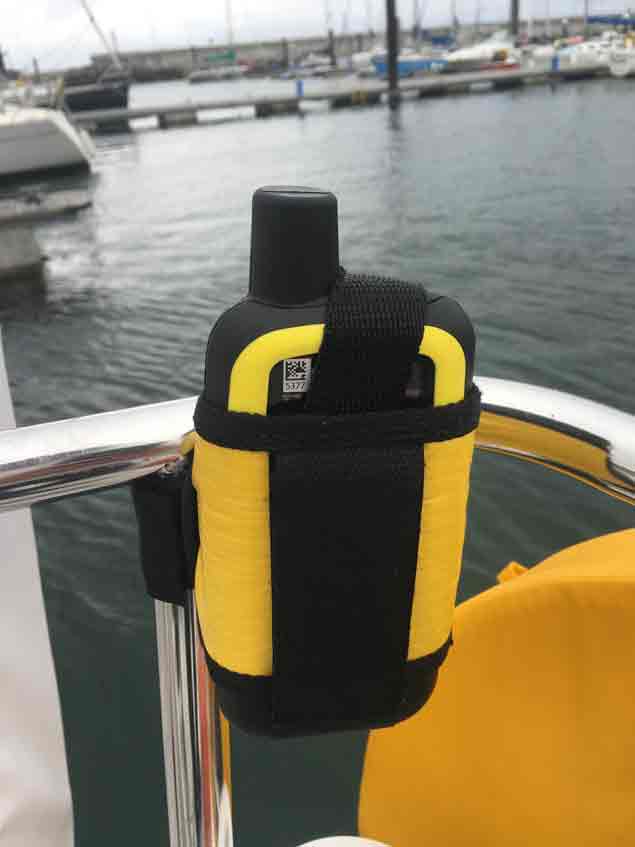 The ubiquitous Yellowbrick Tracker – the mirco-chip used in it was designed in Dublin by the company where top helmsman Noel Butler works.
The ubiquitous Yellowbrick Tracker – the mirco-chip used in it was designed in Dublin by the company where top helmsman Noel Butler works.
That in turn gave him such a good reputation as a helmsman that he is never lacking in offers of berths at the driving end of all sorts of boats, and offshore racing has become his passion. He brings an analytical mind to it - after all, he works with the company in Dublin which designed the micro-chips which are at the heart of the Yellowbrick trackers – and his comments on racing offshore with younger people who have proven themselves in dinghies, but find much great fulfillment offshore on open water, are illuminating:
“Having watched them take the boat by the scruff of the neck and “send it” in big breeze and big seas off Donegal, I for one appreciate the skills they are developing. I didn’t come up through the official “junior sailing world” myself, and am starting to experience it now with my own two kids (aged 7 and 9) sailing Optimists in the programme at the National YC. That’s ultimately aimed towards inshore racing, moving up in boat size. But with that for my family, and with my own experience of seeing more senior juniors such as Lorcan Tighe, Alexander Rumball, Jemima Owens and Oisin Cullen move into the keelboat and offshore game, I see the pluses and minuses of the varied experience of different types of sailing.”
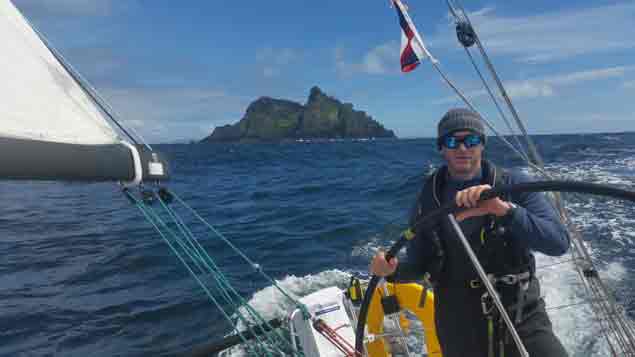 The ocean experience – Noel Butler at the helm of Adelie with Skellig Michael astern during the Volvo Round Ireland Race 2016
The ocean experience – Noel Butler at the helm of Adelie with Skellig Michael astern during the Volvo Round Ireland Race 2016
This “varied experience” is regularly available in Ireland thanks to our tradition of family sailing, while organisations such as WIORA, SCORA and ICRA provide direction for young people looking to test the keelboat experience. But for full introduction to the genuine offshore scene, the Irish National Sailing School and Irish Offshore Sailing in Dun Laoghaire make a formidable contribution, while ISORA is in a league of its own.
 Kenneth Rumball of the Irish National Sailing School in Dun Laoghaire skippered the J/109 Jedi to the class win and victory in the Roger Justice Trophy in the Rolex Fastnet Race 2017. Many Irish offshore racing boats now have INSS “graduates” in their crews
Kenneth Rumball of the Irish National Sailing School in Dun Laoghaire skippered the J/109 Jedi to the class win and victory in the Roger Justice Trophy in the Rolex Fastnet Race 2017. Many Irish offshore racing boats now have INSS “graduates” in their crews
The Irish Sea Offshore Racing Association is guided by Peter Ryan of Dun Laoghaire with such patient skill and success that it could be a template of how to do such things. His own modest approach to it is surely part of it all. Far from claiming to be an offshore racer from boyhood, he quips: “I was an old man of 20-22 when Liam Shanahan Senr dragged me out of the snooker room in the National YC to go offshore racing on his DB2s Lightning – Liam was his own unique and very effective press gang. I’ve been well and truly hooked on offshore racing ever since, and it’s a great encouragement to me that so many young people – some of them very young – are getting a taste for racing offshore thanks to ISORA”.
 Peter Ryan of ISORA was “press-ganged into offshore racing by Liam Shanahan Senr”.
Peter Ryan of ISORA was “press-ganged into offshore racing by Liam Shanahan Senr”.
So there is a sort of informal junior training programme within contemporary offshore racing. It’s just not highly visible because there’s no such thing as a junior offshore racing boat. But doubtless as the years go on, the “programme” will become more developed, as it already is with the sailing schools.
That said, the present setup has considerable charm. It’s intensely personal, it’s friendship and family-based. But if offshore racing is brought within the Olympic circus, then a high profile part of it will acquire an entirely different status. It will become official. It will become easy for governments to recognise its existence. It will become inevitable that, for some sections of the sport, a strict training and qualification and grading system will come into being, making it ultimately a section of sailing developing for a new elite.
Irish offshore sailors will view that with mixed feelings. For there really is something special about the way the system – such as it is nowadays – works quietly and so well in its unobtrusively effective way.



























